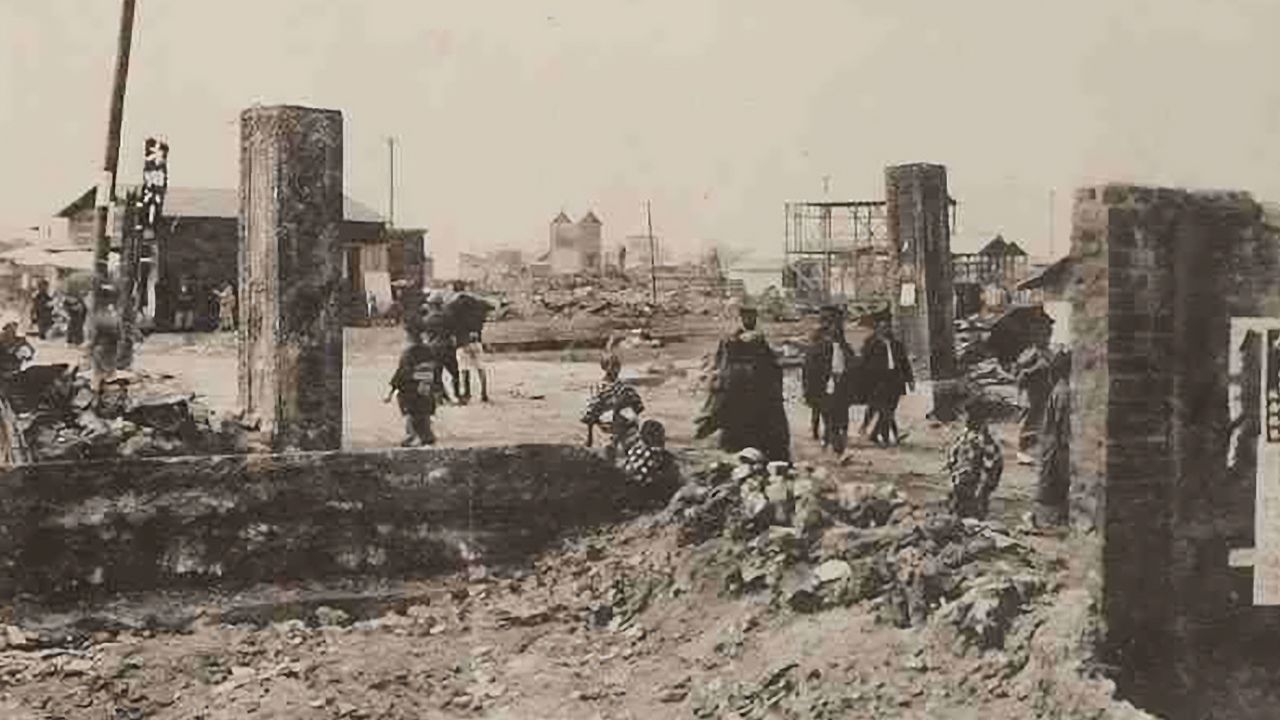
A Yoshiwara Revival: A Century After the Great Kantō Earthquake
Guideto Japan
History Disaster Travel- English
- 日本語
- 简体字
- 繁體字
- Français
- Español
- العربية
- Русский
Many Lives Lost
The Great Kantō Earthquake devastated Tokyo and nearby areas 100 years ago. The magnitude 7.9 quake, which left over 105,000 people dead or missing, struck at 11:58 am on September 1, 1923.
As it was near lunchtime, people were preparing food and cooking fires spread wildly, fanned by strong winds. Over 200,000 structures in and around Tokyo were destroyed or damaged, most of them by fire.
Photos of the devastation in the capital were transmitted throughout the country. Some of the most shocking sights, such as the Great Buddha statue in Ueno Park missing its head, and the Asakusa Ryōunkaku, a 12-story building that was Japan’s first skyscraper, with its upper floors destroyed, were later made into picture postcards. As Ueno and Asakusa were prime leisure spots, people across Japan were aghast at the damage and destruction.
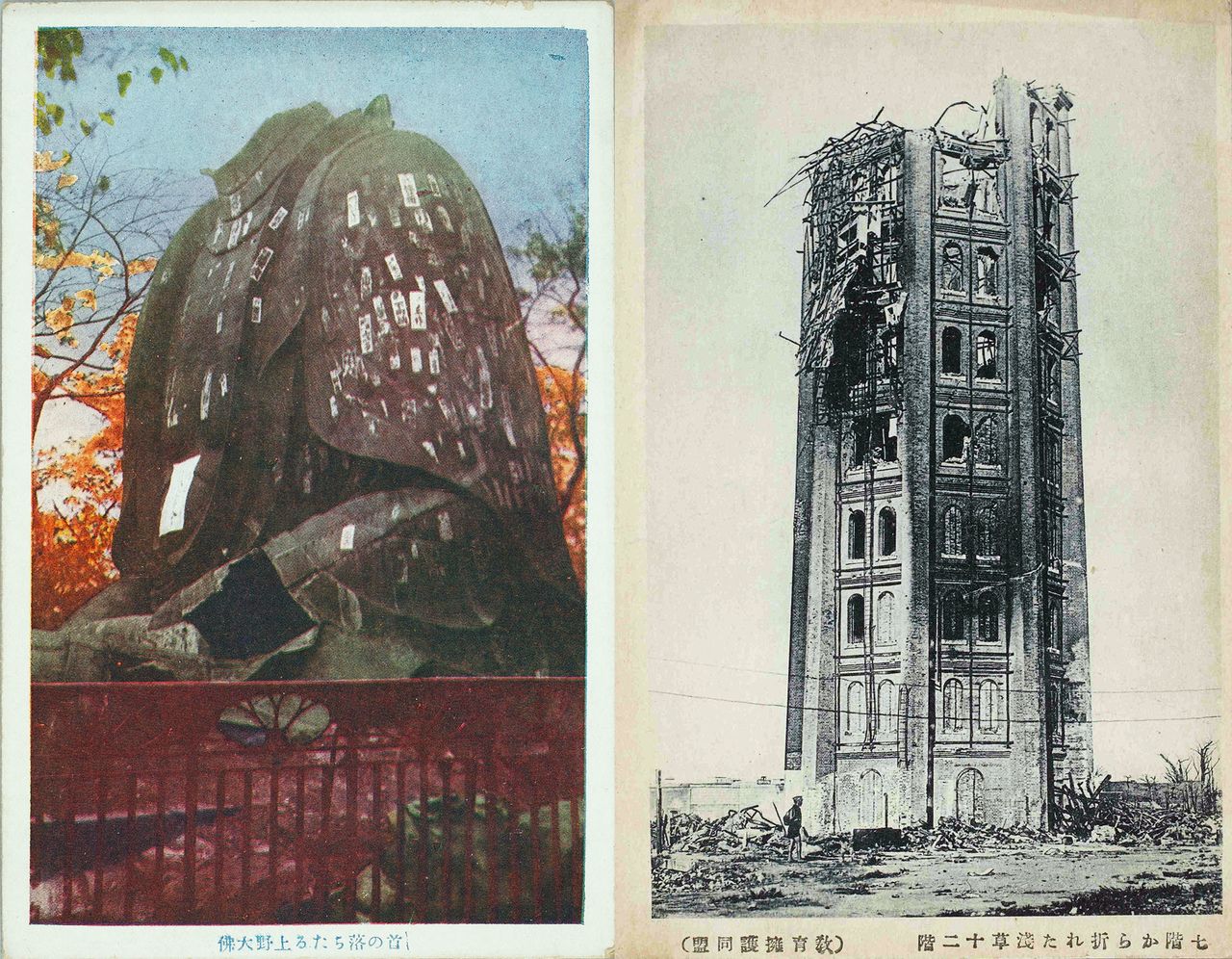
Picture postcards on sale after the earthquake, with Ueno Park’s Great Buddha on the left and the Ryōunkaku on the right. (Courtesy Tokyo Metropolitan Library)
But to tell the whole story of the earthquake’s repercussions, it is necessary to touch on another entertainment area bordering Asakusa: the Yoshiwara pleasure quarters, in today’s Taitō.
Surrounded by a moat, Yoshiwara, where prostitution had been officially permitted since the Edo period (1603–1868), teemed with houses of assignation. The district suffered devastating damage, fires broke out from collapsed buildings, and the flames spread rapidly. Those who managed to escape headed for Benten-ike, a pond in nearby Hanazono Park (today Shin-Yoshiwara Park), to get away from the wall of fire closing in on them. But unable to withstand the flames and smoke, they jumped into the pond; over 500 people perished there.
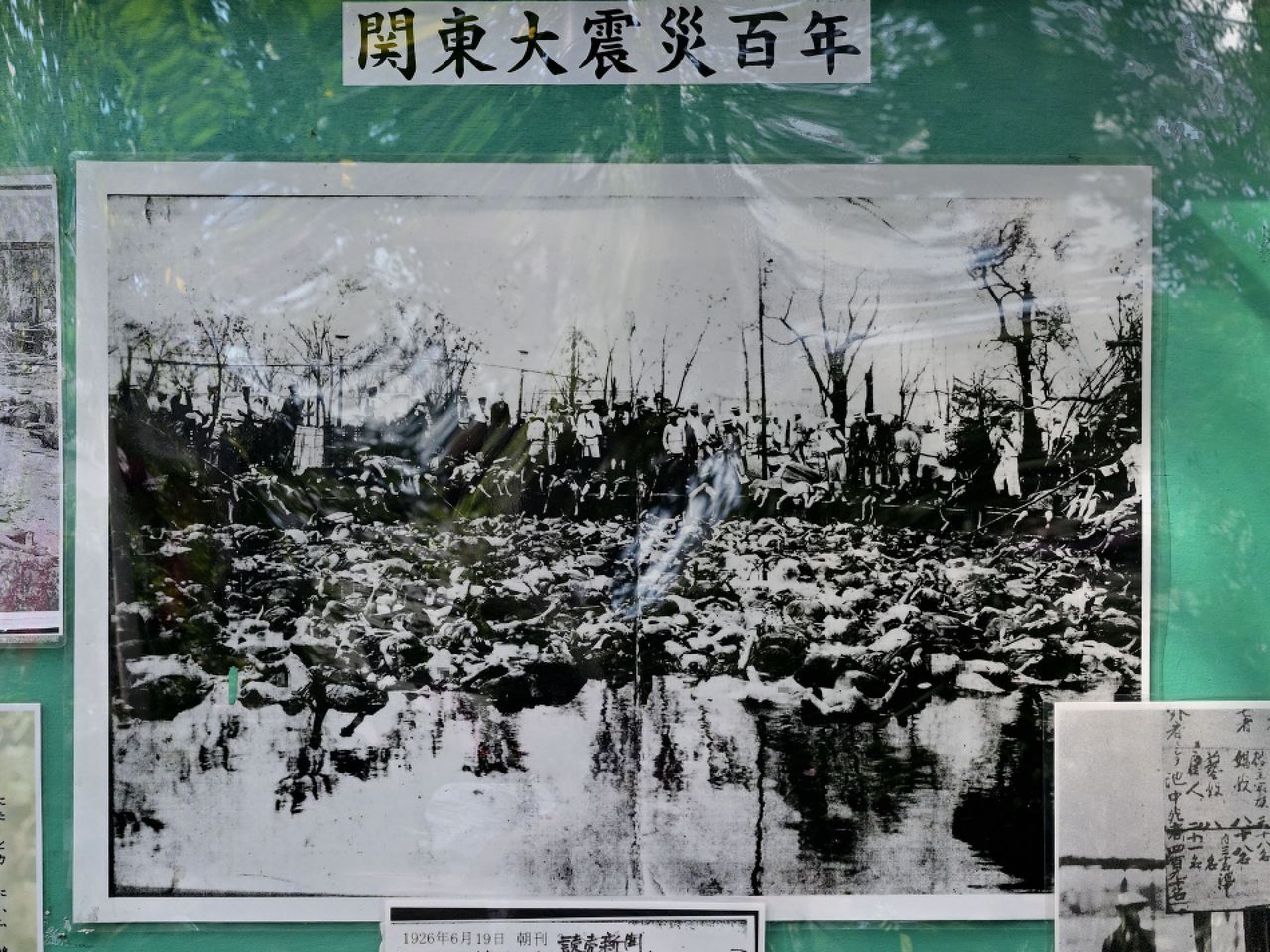
A photo of the scene at Benten-ike displayed at the Yoshiwara Benzaiten shrine. (© Kichiya)
Transmitting Yoshiwara’s Vibrant Culture Anew
I have come to specialize in photographing modern-day scenes associated with ukiyo-e landscapes, and have a built a connection with Yoshiwara, scenes of which were immortalized in woodblock prints. I have been to the area dozens of times both to take photos and for research. My photographs have also led to invitations to events related to Yoshiwara.
I am currently the director of Tōkōjuku, a group formed by interested parties to promote research in and dissemination of Yoshiwara’s history and culture. I have edited a guidebook to the area published by the Yoshiwara Business Association and also created the design for Yoshiwara Jinja’s goshuin, a seal stamp granted to worshipers and visitors to the shrine.
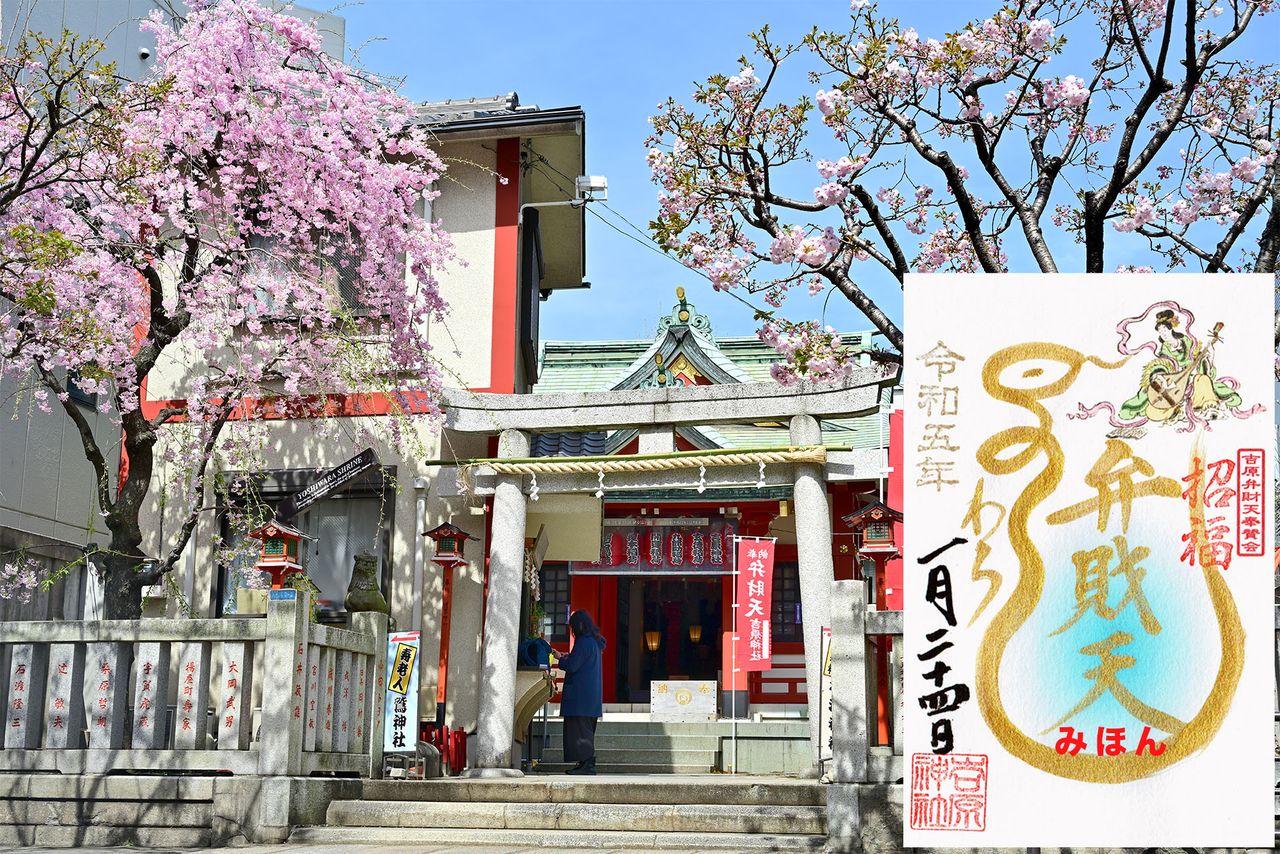
The sacred Aizome cherry tree at Yoshiwara Jinja and the Yoshiwara Benzaiten goshuin designed by Kichiya. (© Kichiya)
Today’s Benten-ike pond, much smaller than the original, is in the precincts of Yoshiwara Benzaiten, the inner shrine of Yoshiwara Jinja. Improvements to the pond are being made this year, in conjunction with a religious service marking the hundredth anniversary of the quake.
Now the directors of the Yoshiwara Jinja Association and Yoshiwara Tatsuo, head of the Federation of Yoshiwara District Neighborhood Associations, hope to do away with Yoshiwara’s past unsavory image and bring back the color and liveliness of the district’s Edo period days. Until now, many events had focused on praying for earthquake and World War II victims and for the women of Yoshiwara, but as part of the movement to spotlight a new Yoshiwara, a small water feature is being constructed at Benten-ike.
An additional incentive is the legions of young fans, both from Japan and abroad, flocking to the area, drawn by the fact that hugely popular anime Demon Slayer: Kimetsu no Yaiba is set in Yoshiwara. The local neighborhood and merchants’ associations have also got together to revive the area’s past glories, from an oiran high-ranking courtesan procession in April to a September event featuring impromptu skits .
Here I look at the history of Yoshiwara and Benten-ike, the damage from the earthquake, and what is being done to revitalize the area.
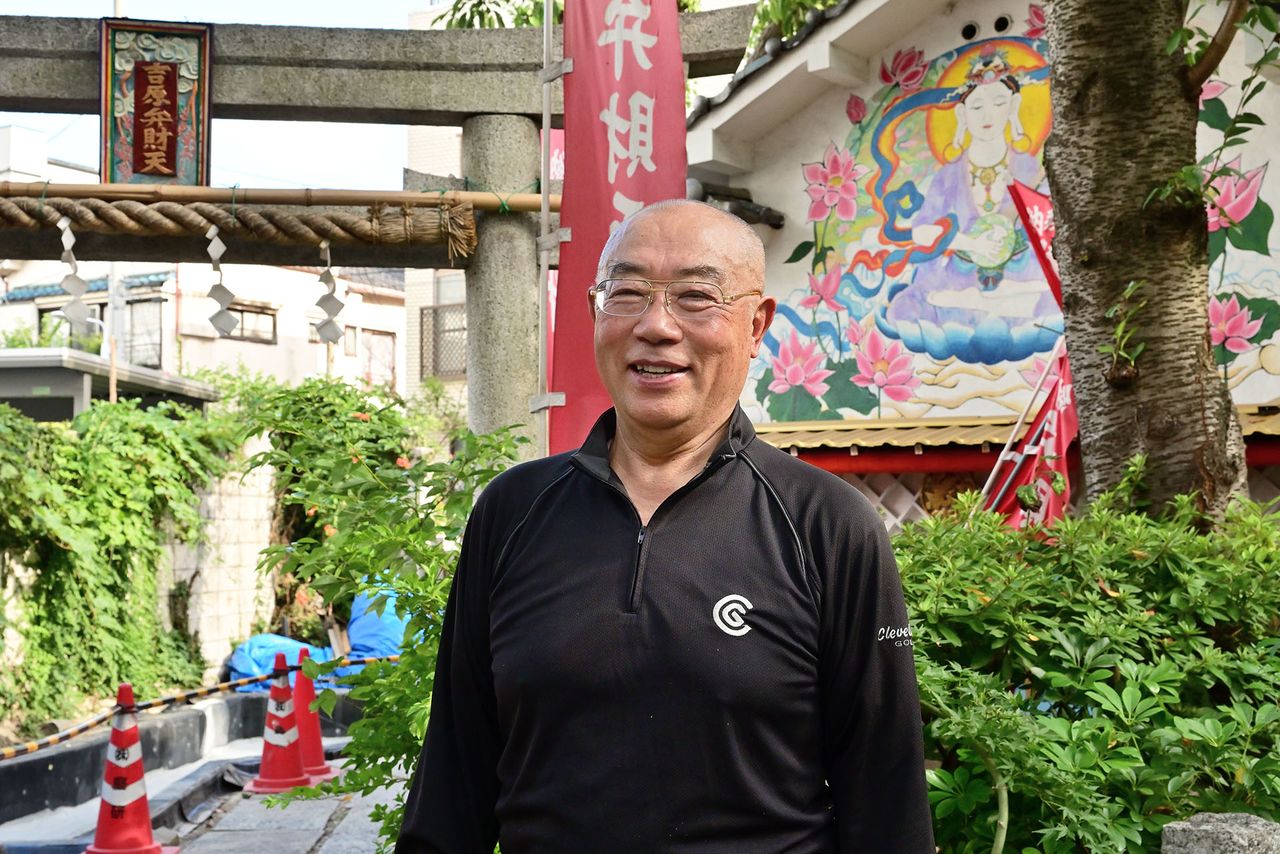
Yoshiwara Tatsuo at Benten-ike, where a water feature is being added. (© Kichiya)
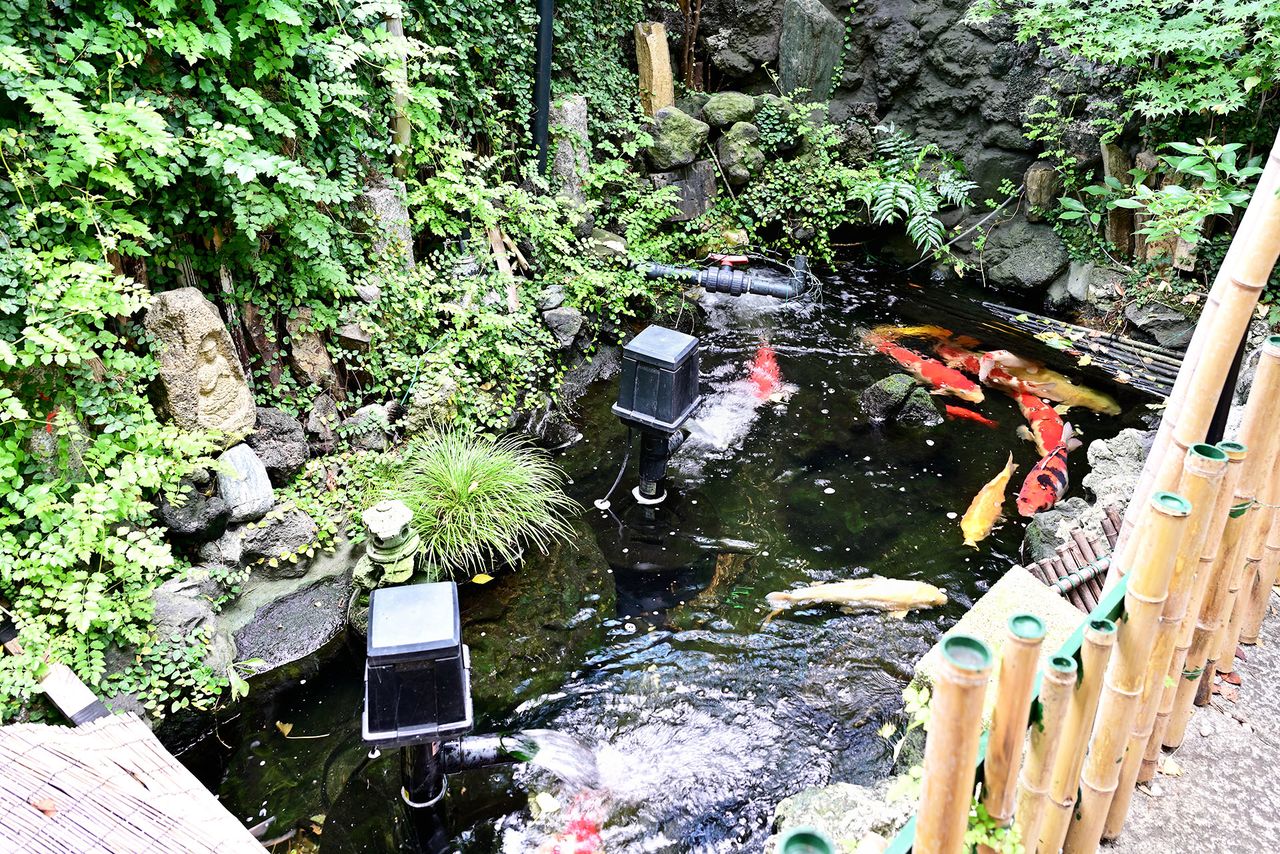
The refurbished Benten-ike is slightly larger than before. (© Kichiya)
Cradle of Edo’s Distinctive Culture
In 1617, the shogunate established Yoshiwara as the only licensed quarters in Edo (now Tokyo). At first located close to present-day Ningyōchō in Chūō, in 1657 the quarter was moved to Asakusa in what is now Taitō due to expansion of the city to accommodate a growing population. Despite the new location being inconvenient, in the peaceful times of the Edo period crowds were drawn to the theaters and other places of entertainment that sprang up, making Yoshiwara the liveliest district in Edo.
Although by today’s values pleasure quarters are viewed in a negative light, Yoshiwara at the time was a vibrant social center for men, with salons where literati gathered. Banquets were enlivened by educated prostitutes and by male and female performers trained in traditional arts. Yoshiwara was an incubator of culture, and theater, music, publishing, and fashions born there took Edo by storm.
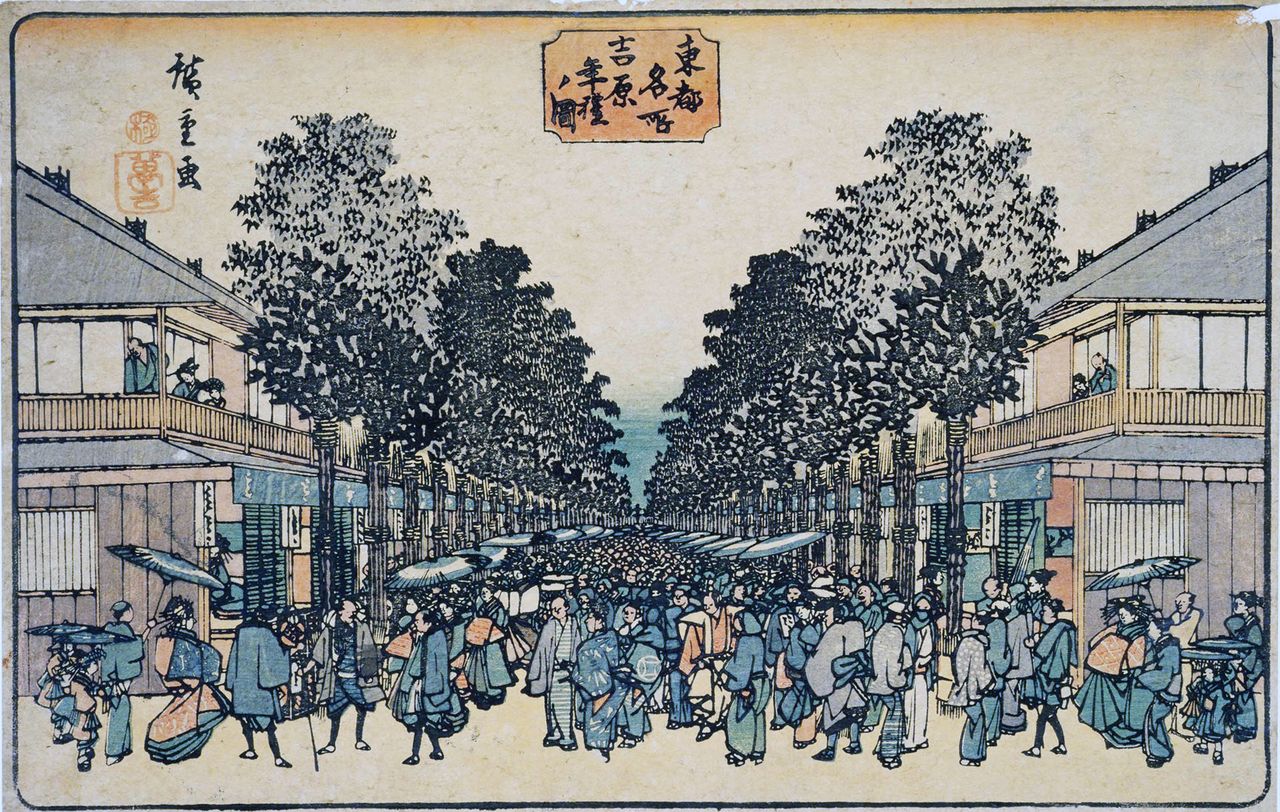
Tōto meisho Yoshiwara nenrei no zu (Landmarks of Edo: New Year Greetings at Shin-Yoshiwara), a woodblock print by Utagawa Hiroshige shows crowds milling about in Yoshiwara to exchange New Year greetings. (Courtesy National Diet Library)
A Popular Entertainment Center
The vibrant atmosphere of Yoshiwara suffered after the Meiji Restoration of 1868. Influenced by Western ideas about morality, in 1872 the new government ordered female “entertainers” to disband. The aim was to make a distinction between geisha and those who, officially, were licensed prostitutes. As a result, calls for the latter to entertain at banquets decreased, and the famous oiran processions were discontinued.
In the late nineteenth century, Benten-ike pond was created in Hanazono Park, adjacent land southwest of the licensed quarters. The park became an oasis for both neighborhood residents and people working in Yoshiwara.
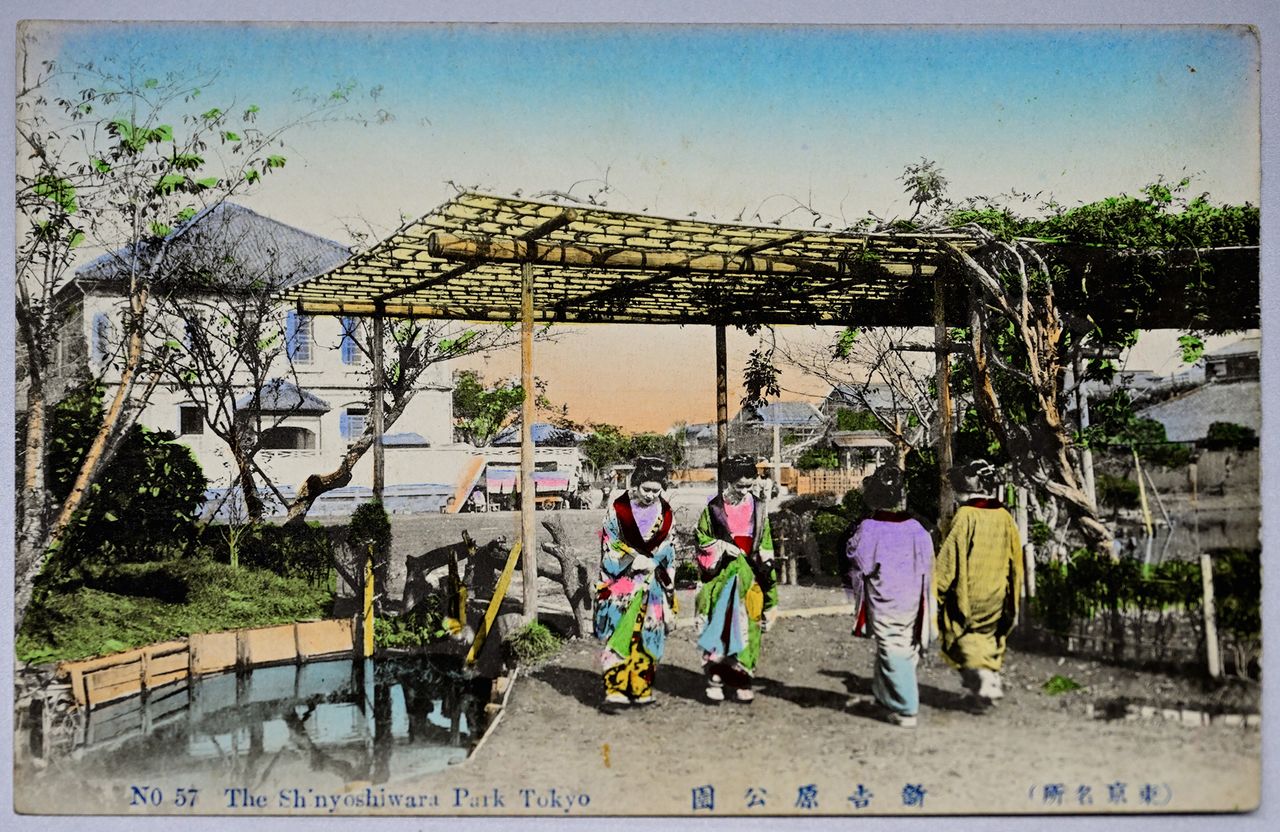
This picture postcard, Tokyo meisho Shin Yoshiwara kōen (Tokyo Landmark Shin-Yoshiwara Park), created from a hand-colored photo shows two prostitutes strolling, with Benten-ike partially visible in the left foreground. (Taishō era (1912–26), courtesy private collection)
Emerging awareness of human rights in the early decades of the twentieth century led to the outlawing of harimise, rooms in the front of the brothels with grilles behind which prostitutes were displayed for customers. More Western-style structures were erected, greatly changing the quarter’s appearance. Even so, the “brand” extant since the 1600s lived on, and the Yoshiwara of the day was often depicted on picture postcards.
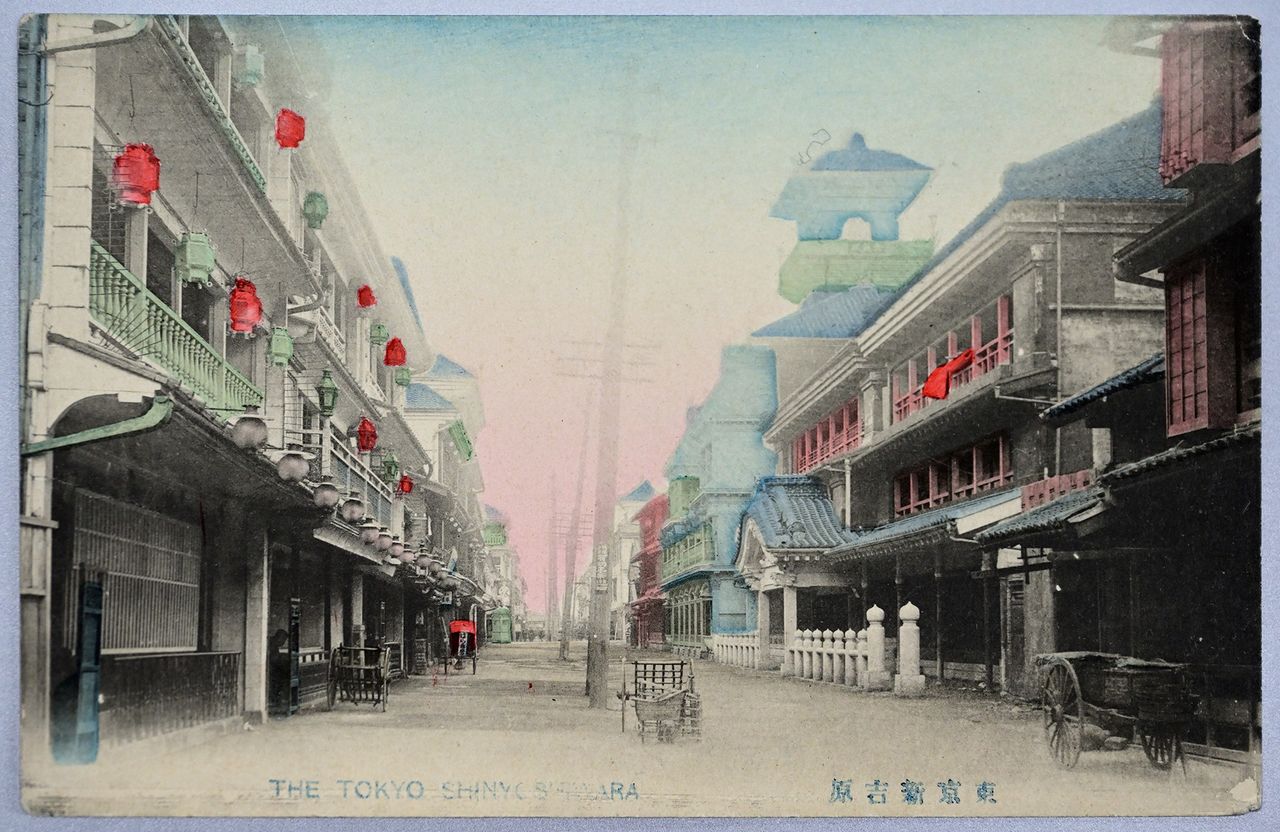
Brothels line the street in this Tokyo Shin-Yoshiwara picture postcard. (Taishō era, courtesy private collection)
Devastation and Wild Rumors
On September 1, 1923, the Great Kantō Earthquake leveled Yoshiwara. The district was filled with three-story buildings, unusual for Tokyo at the time, and people perished when those buildings collapsed. Many structures were built of wood; fire spread rapidly, greatly increasing the number of victims.
But many facts were distorted. One frequent assertion was that Yoshiwara had only one entrance, the Central Gate, and that this gate was shut, preventing people from fleeing and leading to the deaths of 490 prostitutes in Benten-ike. In fact, there was no barrier in the Central Gate at the time, and the quarter’s six emergency exits were also open. Besides, the entrance to Yoshiwara had always been open in the daytime, so given that the earthquake struck shortly before noon, in any case the entrance would not have been closed. In addition, Benten-ike lay outside the quarter, so the claim that people could not escape, when so many died there, does not make sense.
The number of prostitutes who died at Benten-ike was also vastly overstated. Police records at the time put the number of Benten-ike fatalities at a little over 500. This supposedly included nearly 500 prostitutes, but that would mean that they accounted for nearly all the deaths. A neighborhood record gives more a more accurate breakdown, putting the number of victims from the Yoshiwara quarter at 155, of which 38 were brothel owners or family members, 88 prostitutes, 8 geisha, and 21 employees. There were also 490 victims from ordinary neighborhoods. From this we can see that fewer than 100 of the dead were prostitutes, so it seems that the numbers were switched around to sensationalize the tragedy.
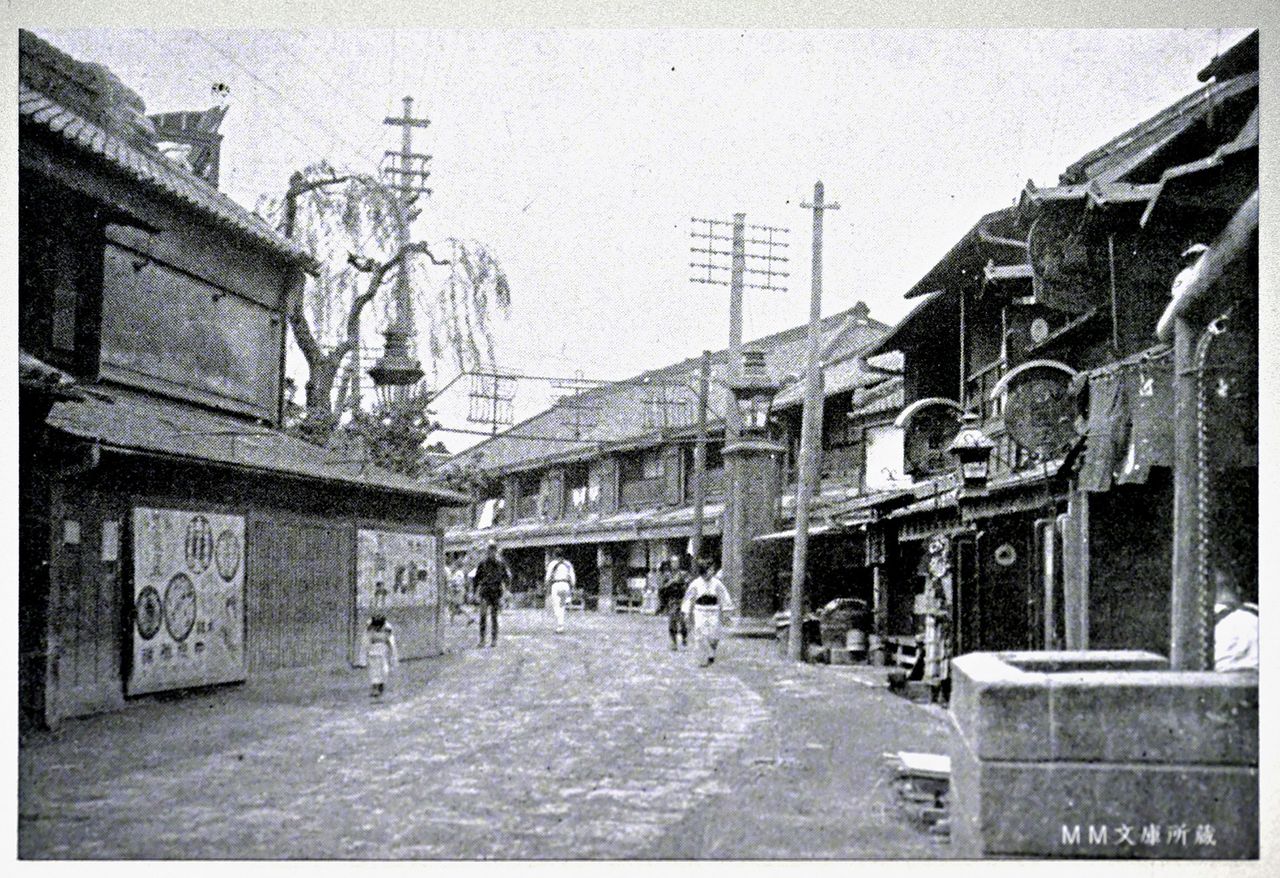
Picture postcard depicting the street near Yoshiwara’s Central Gate before the earthquake. (Courtesy private collection)
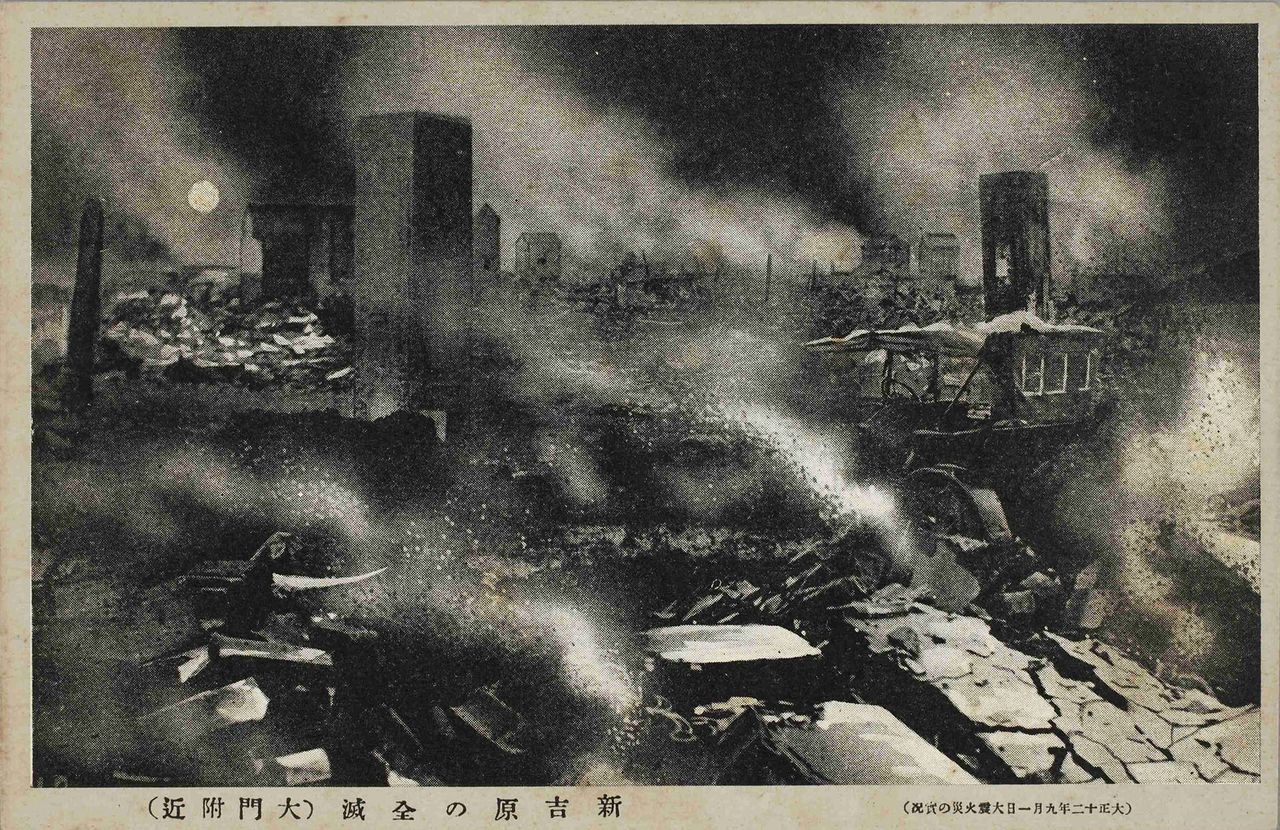
Picture postcard showing total destruction of the Yoshiwara quarter near the Central Gate. By late afternoon on September 1, only the gate’s pillars were left standing, and the area was shrouded in smoke. (Courtesy Tokyo Metropolitan Library)
A comparison of picture postcards of the era shows the extent of the destruction in Yoshiwara, but some photos highlighted the district’s typical resilience.
In this photo dated October 23, less than two months after the earthquake, a solitary makeshift structure, with a banner announcing “Hongō Bar,” stands in the rubble. No matter the circumstances, the people of Yoshiwara were tough and their playful spirit shone through.
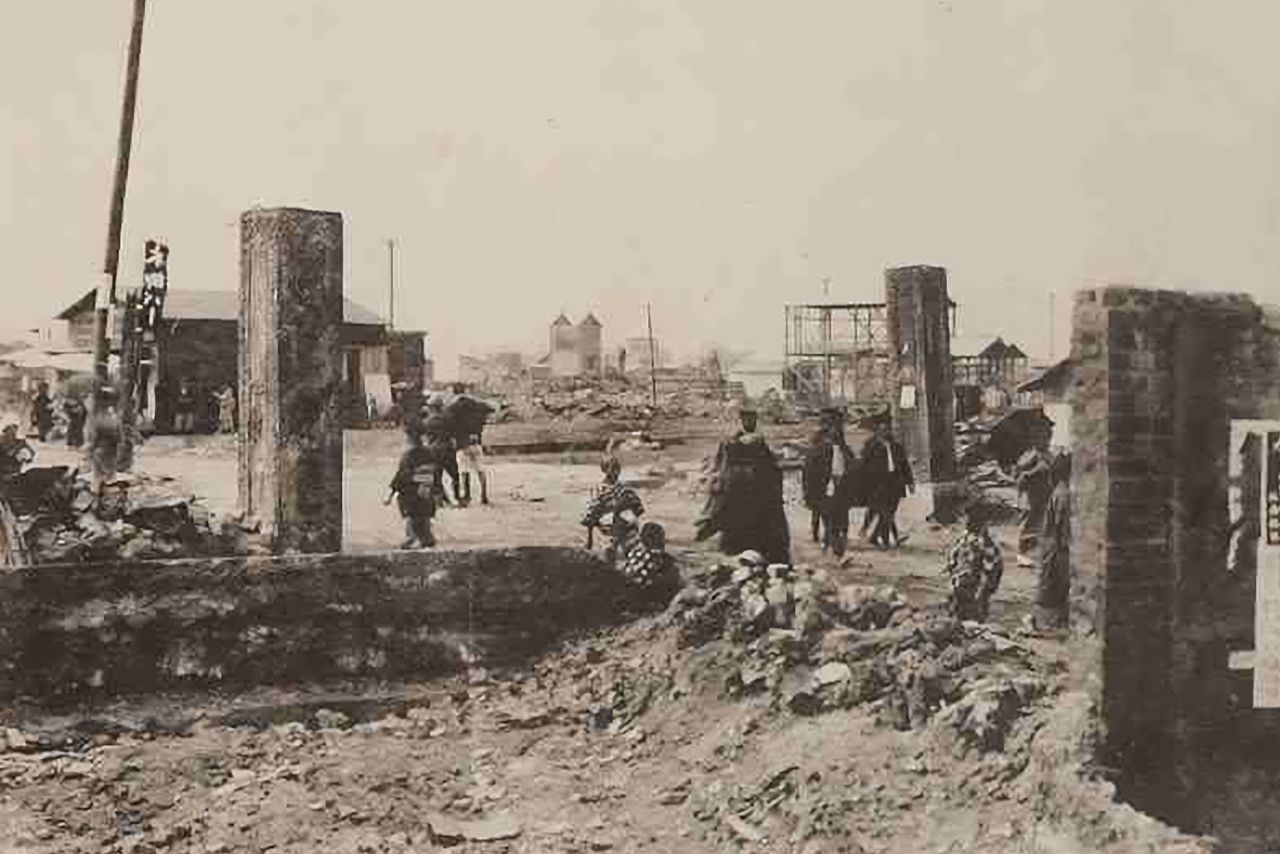
In this photo, the area near the Central Gate has been cleared of rubble. A solitary structure housing a bar stands in the background. In Tokyo shinsairoku chizu oyobi shashinchō (Pictorial Record and Maps of the Great Kantō Earthquake), published in 1926. (Courtesy Tokyo Metropolitan Library)
Yoshiwara Reborn
On September 1, 1924, the first anniversary of the disaster, a Buddhist service was held to pray for those who had died at Benten-ike. Three years later, a statue of Kannon, the deity of mercy, was erected on the banks of the pond to remember the dead, and a service has been held every year since then.
Yoshiwara recalls that when he was a child, the park still had its large pond, which was filled in in 1959. The recreated pond within the grounds of Yoshiwara shrine is smaller than the original.
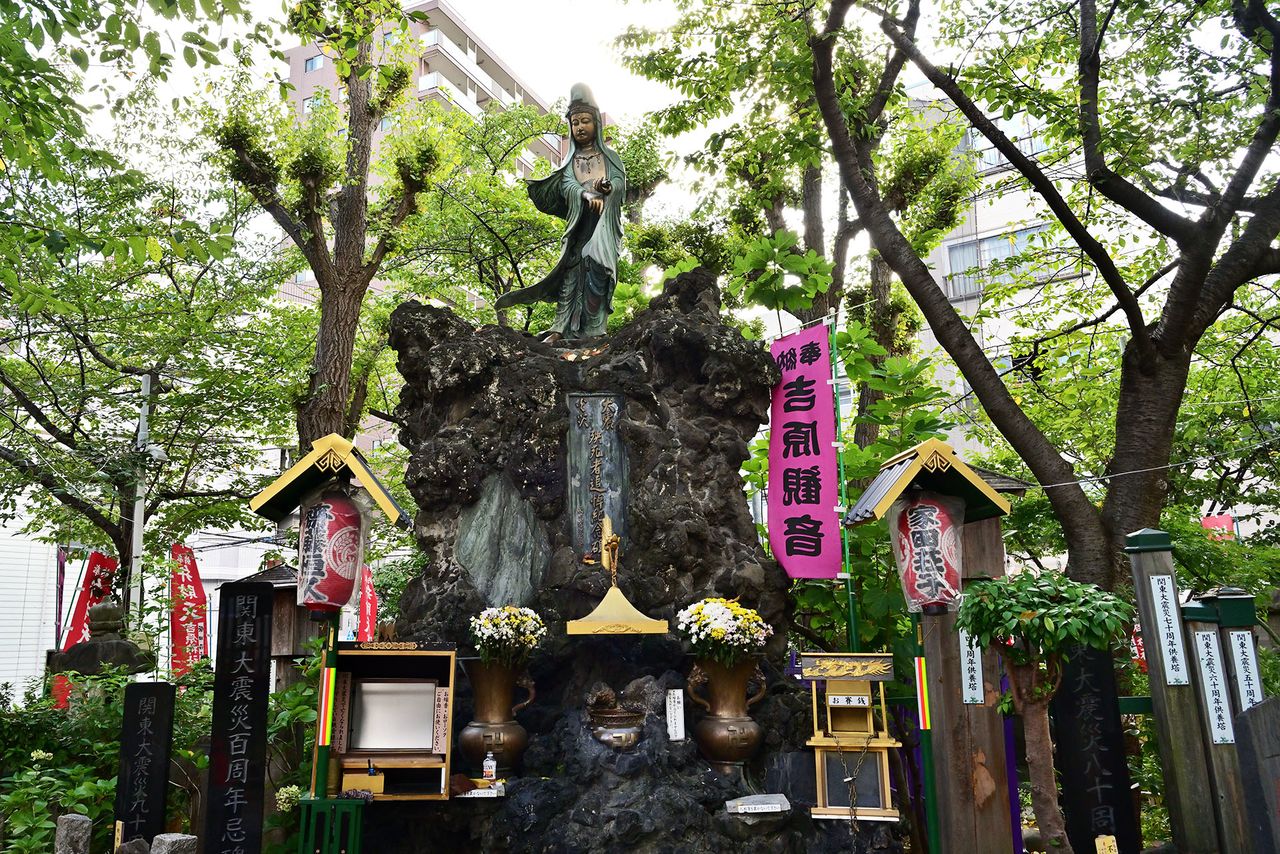
The statue of Kannon and the pond were moved to their new location. (© Kichiya)
The Yoshiwara district was severely damaged again during World War II, and the passage of the Anti-Prostitution Act of 1958 dealt a further blow to its vibrancy as one of Tokyo’s “must-visit” spots. But in recent decades, there has been a renewed appreciation of Yoshiwara as a wellspring of Edo culture. More tourists have been visiting the area, and an exhibition on Yoshiwara will take place in March 2024 at the University Art Museum, Tokyo University of the Arts.
Following the refurbishment of Benten-ike, Yoshiwara Tatsuo plans to revive other landmarks and traditions of the area, beginning with rebuilding the Central Gate and restarting the midsummer custom of hanging lanterns all along Yoshiwara’s Nakanochō main street in memory of famous courtesan Tamagiku. He hopes to encourage knowledge and understanding of Yoshiwara’s history and traditions, and is busily planning events that will appeal to visitors to the area. A century after the Great Kantō Earthquake, Yoshiwara aims to recover its past vitality.
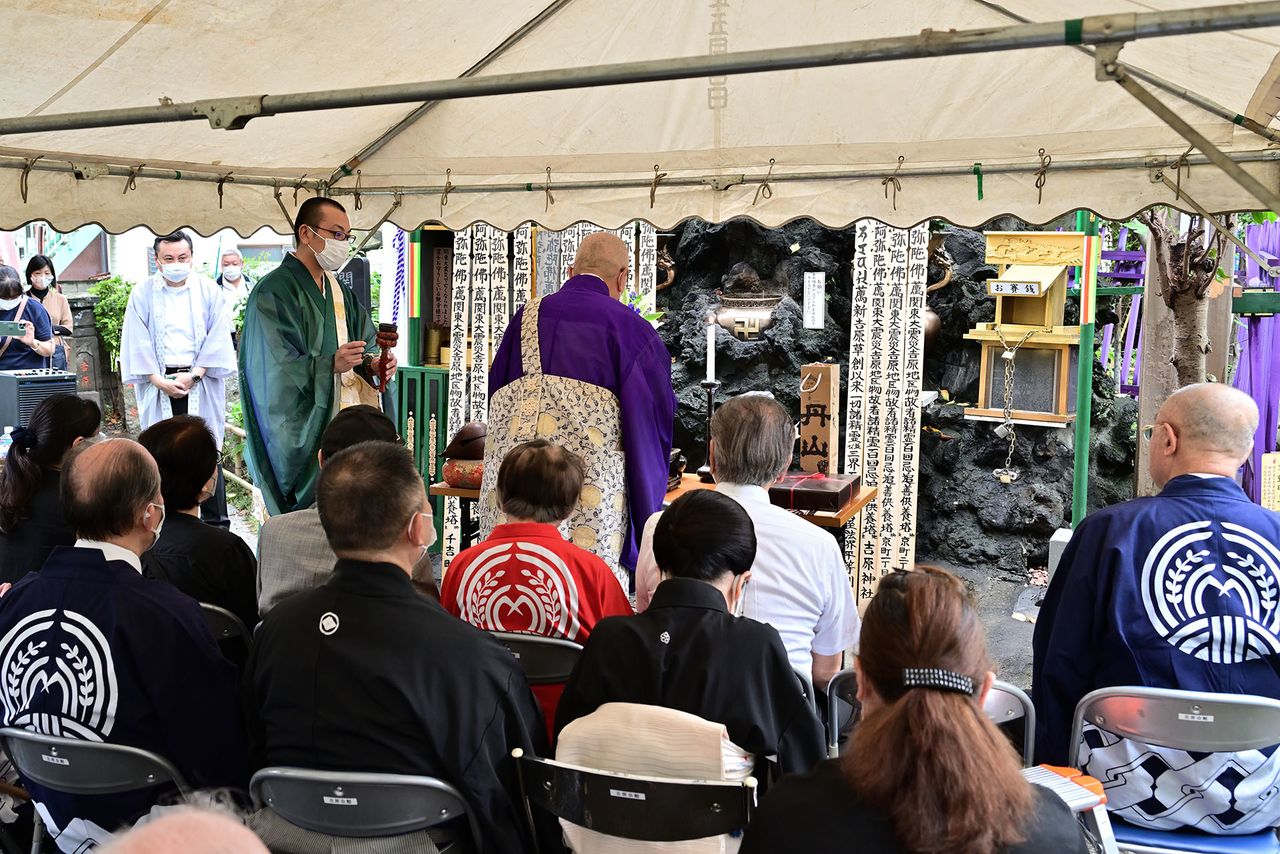
A Buddhist service took place on September 1, 2022, marking the ninety-ninth year after the earthquake. (© Kichiya)
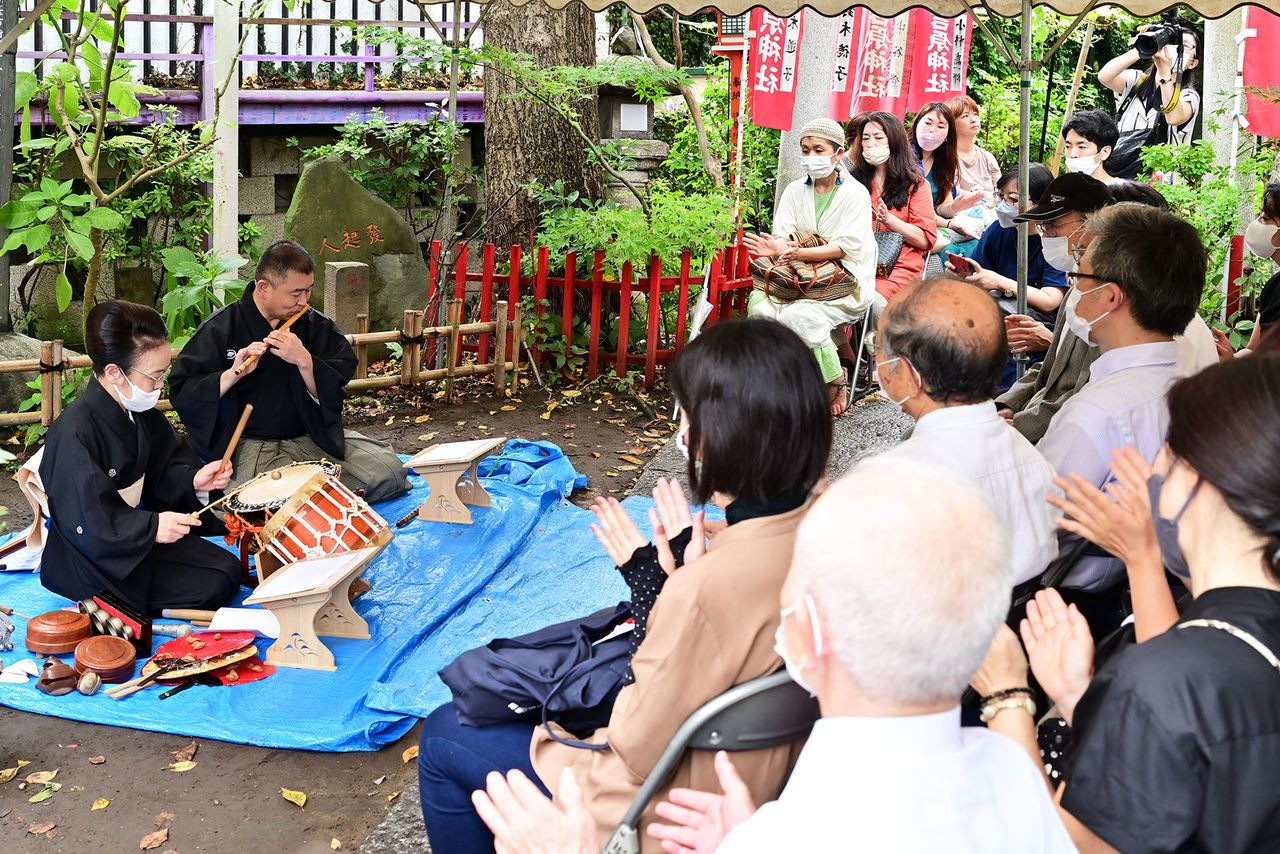
Many people attended the ceremony to enjoy a performance offered as part of the service. In the photo are traditional storyteller Mochizuki Tazae and a member of his troupe. (© Kichiya)
(Originally published in Japanese. Photos by Kichiya unless otherwise noted. Banner photo: Yoshiwara after the earthquake. In Tokyo shinsairoku chizu oyobi shashinchō (Pictorial Record and Maps of the Great Kantō Earthquake), published in 1926. Courtesy Tokyo Metropolitan Library.)